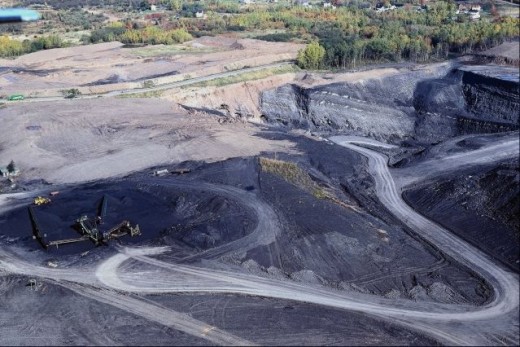Radioactivity in Coal

Coal or Nuclear?
Would you suppose that nuclear power plants are a present danger to people who live near them, or even at a distance? It hasn’t proven to be that way other than for the meltdown at Chernobyl. Chernobyl caused considerable harm and still does so. Chernobyl was an anomaly, and there have been no other Chernobyls, either before or since. People talk about the Three Mile Island accident, the one where a little bit of radioactive tritium was released into the atmosphere. There were no documented injuries or illnesses from that. There have been no more Three Mile Islands since that one.
Would you believe that the burning of coal might even be a nuclear resource, or, as this article will explore, a radiation exposure danger to those who live nearby coal-fired power plants?
Where would you prefer to reside – close by a nuclear power plant or next door to a coal-fired power plant?

A Clean Coal-Fired Power Plant?
Before you answer that question, consider this: You can wander all over the world looking for a "clean" coal-fired power plant, but you are most unlikely to find one.
Here is a quotation from an article by Alex Gabbard. (Although you may not believe his words, they are words to which you should pay attention):
"Americans living near coal-fired power plants are exposed to higher radiation doses than those living near nuclear power plants..."
Most electrical generation, 52% or so, in the United States is from coal-fired plants. Coal is cheap. Coal is plentiful. Burning coal is "dirty." There are a number of not-so-nice things that go up into the air around coal-fired power plants – for example: sulfur and nitrogen oxides and various other gaseous pollutants that contribute to the general neighborhood stink and to such as acid rain. But – there are several items that exit those tall smokestacks that few people know about, and those who do know about them generally do not do much talking about them. What are they?
Radioactive materials that occur naturally – mostly thorium and uranium and the many radioactive daughter products that descend from them.
That’s right. An ordinary lump of dark black coal is loaded with radioactivity. When you burn coal, some of the radioactivity goes up into the air, and some remains within the coal ash. If you breathe that air, some radioactivity enters your body. If it rains and the water leaches radioactivity from a huge pile of coal ash at the power plant, the radioactivity enters the soil in the area and travels with the water down into the water table below that serves both that locale and those downstream as well.
It has been estimated that the ratio of thorium to uranium in coal is probably about 2.5 to 1, the measured quantities of which may average 3.2 to 1.3 parts per million respectively for the two contaminating elements. This can vary considerably, with some coal specimens showing uranium concentrations of between 1 and 10 parts per million, with thorium typically being in 2.5 times greater concentration as noted earlier.
If everything remains about the same as it is today, coal-fired power plants in the United States will release 10,000 tons of thorium and just short of 5,000 tons of uranium into the atmosphere in the year 2037, up from the current levels of 6,000 tons and 2,500 tons each, respectively. Those are big numbers. Overall, the atmospheric releases plus the residual amounts in coal ashes will come to a staggering 145,000-plus tons of uranium and an even larger, 357,000 tons of thorium in 2037 – just within the United States.
All of this radioactivity can "dose" people living close by coal-fired power plants. Do you have to live next door to such a power plant to get a radiation exposure from it? No, but the closer you are, the more your numbers will contribute to the national average, difficult to accurately measure, but which is higher than it need be. Keep in mind that there is no threshold amount of radiation below which radiation does no harm to the body. Any amount of radiation you receive but do not need for some legitimate purpose is harmful.
Those are some of the bad things that come about by using coal to fire electrical power plants.

What to Do?
Can there be any good in coal having this sort of radioactivity contaminating it? Yes, but dealing with that contamination requires, first, that it is widely recognized as being there, and finally, deciding to use the contaminants rather than to discard them. So, we can see that there is a public education requirement and also a need for a nationwide, possibly a worldwide, decision to take advantage of monetarily valuable radiochemical resources that, are now being simply wasted and are allowed to be a dangerous nuisance.
Those tons and tons of radioactive materials can be salvaged and put to use in many different ways, one of which would certainly be in one form or another of nuclear power plants. It seems to be most bizarre that the energy value of the coal being used to fire conventional electrical power plants is less than that of the materials being thrown away and allowed to contaminate the environment with radioactivity and other pollutants. Yes, burning coal to produce electrical power wastes more energy than it produces.
Think about that, and, if you live near a coal-fired power plant, take a deep breath and think about it some more.
Source of some of the above information: Oak Ridge National Laboratories








